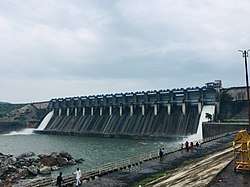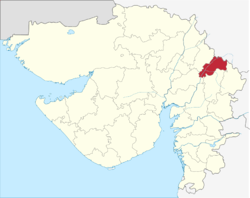Mahisagar district
Mahisagar district – also Mahisagar – is a district in the state of Gujarat in India that came into being on 26 January 2013, becoming the 28th district of the state. The district has been carved out of the Panchmahal district and the Kheda district. District Name Mahisagar given from "Mahi River".[1] Lunawada is the district headquarters of Mahisagar. It started its operation in full-fledged from 15 August 2013
Mahisagar district | |
|---|---|
district | |
 Mahi Bajaj Sagar Dam | |
 Location in Gujarat | |
| Coordinates: 23.133°N 73.6167°E | |
| Country | |
| State | Gujarat |
| Established | 26 January 2013 |
| Named for | Mahi River |
| Government | |
| • Type | District Panchayat |
| Area | |
| • Total | 2,260.64 km2 (872.84 sq mi) |
| Population (2011) | |
| • Total | 994,624 |
| • Density | 440/km2 (1,100/sq mi) |
| Languages | |
| • Official | Gujarati, Hindi, English |
| Time zone | UTC+5:30 (IST) |
| PIN | 389230 |
| Telephone code | +912674 |
| Vehicle registration | GJ-35 |
| Website | http://mahisagar.gujarat.gov.in/ |
Talukas
Mahisagar district consist of 6 talukas:
Dinosaur fossils
In the early 1980s, palaeontologists stumbled upon dinosaur bones and fossils during a regular geological survey of Balasinor (originally in Kheda District, currently in Mahisagar after formation of the district in 2013), later identified as Rajasaurus narmadensis (Latin for "princely lizard from the Narmada Valley". It was the first dinosaur fossil discovery in India.
The find sent ripples of excitement through neighbouring villages and many residents collected what fossilised eggs they could find., brought them home and worshipped them.[2] Since then, excavations have thrown up a veritable trove of dinosaur remains - eggs, bones, and a skeleton which is now kept in a Kolkata museum - bringing hordes of scientists and tourists to the place.
Piecing together the evidence in Balasinor, researchers now believe that Gujarat is home to one of the largest clutch of dinosaur hatcheries in the world. At least 13 species of dinosaurs lived here, possibly for more than 100 million years until their extinction some 66 million years ago. The soft soil made hatching and protecting eggs easier for the animals. So well-protected are the fossilised eggs found here that many researchers call them the best-preserved eggs in the world after the ones found in Aix-en-Provence in France. These fossilized dinosaur remains triggered off what tourism officials in Gujarat referred to as "dinosaur tourism".
Mangadh Hill
This is an important fair of the tribals and is held on Margshirsha Purnima. At this fair the tribals of Rajasthan, Madhya Pradesh & Gujarat participate and they pay tribute to Guru Govindgiri, founder of the Samp sabha.
References
- "Mahisagar now a district in Gujarat". DNA. 14 August 2013. Retrieved 14 August 2013.
- http://www.thenational.ae/news/world/south-asia/indias-jurassic-park-hopes-princely-lizards-will-attract-tourists